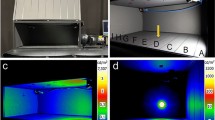Summary
Using an infrared technique based on the continuous monitoring of a characteristic infrared absorption band, temporal variations in the circadian patterns of carbon dioxide release were examined in two species of noctuid moths, the corn earworm Heliothis zea (Boddie) and the fall armyworm Spodoptera frugiperda (J. E. Smith). The detailed emission patterns were shown to be different in the two moth species (Figs. 3, 4). Emission patterns similar to those obtained in adults were also observed to be present in the pupal stage of development.
The influence of light-dark conditions was examined and in the pupal stage the mean rate of carbon dioxide evolution was lower in those pupae exposed to a dark chamber compared with pupae of corresponding age and sex exposed to approximately 80 foot candles of light. This light-dark effect was not observed in adult moths. An insect attractant lamp emitting radiation in the blue and ultraviolet regions of the spectrum was found to have a pronounced stimulating influence. Over a 24 hour period of observation, the carbon dioxide buildup was approximately two times greater from male S. frugiperda moths exposed to the attractant lamp when compared with control moths exposed to room light or dark chamber conditions (Fig. 5). Alternate 24 hour exposures to the attractant lamp and dark conditions disclosed that the moths returned to a low level of emission following each light exposure. The attractant lamp also altered the phasing or onset of the circadian pattern of carbon dioxide release, however, the sequential patterns of release remained the same.
Similar content being viewed by others
References
Adkisson, P. L.: Internal clocks and insect diapauses. Science 154, 234–241 (1966).
—, E. Vanderzant, D. L. Bull, and W. E. Allison: A wheat germ medium for rearing the pink boll Worm. J. econ. Entomol. 53, 759–762 (1960).
Agrell, I., in: Physiology of insecta, vol. I (M. Rockstein, ed.), p. 130. New York and London: Academic Press 1964.
Bünning, E.: The physiological clock, p. 97. Berlin-Heidelberg-New York: Springer 1967.
Deay, H. O., J. R. Barrett, Jr., and J. G. Hartstock: Field studies of flight response of Heliothis zea to electric light traps, including radiation characteristics of lamps used. Proc. North Cent. Branch Ent. Soc. Amer. 20, 1009–1019 (1965).
Levengood, W. C., and W. L. Wolfe: Optical method for monitoring the pCO2 level in physiological liquids. Proc. San Diego Symp. Biomed. Eng., vol. 4, LaJolla, Calif., p. 424–433 (1964).
Levy, R. I., and H. A. Schneiderman: Discontinuous respiration in insects. — II. The direct measurement and significance of changes in tracheal gas composition during the respiratory cycle of silkworm pupae. J. Insect Physiol. 12, 83–104 (1966).
Miller, P. L., in: Physiology of insecta, vol. III (M. Rockstein, ed.), p. 591–594. New York and London: Academic Press 1964.
Slama, K.: Physiology of sawfly metamorphosis — I. Continuous respiration in diapausing prepupae and pupae. J. Insect Physiol. 5, 341–348 (1960).
Author information
Authors and Affiliations
Additional information
This work was sponsored by the U.S. Department of Agriculture, Agricultural Engineering and Entomology Research Divisions, ARS, Beltsville, Md. Contract No. 12-14-100-8942 (42).
Rights and permissions
About this article
Cite this article
Levengood, W.C. Infrared method for determining circadian patterns of carbon dioxide release. Z. Vergl. Physiol. 62, 153–166 (1969). https://doi.org/10.1007/BF00302280
Received:
Issue Date:
DOI: https://doi.org/10.1007/BF00302280




